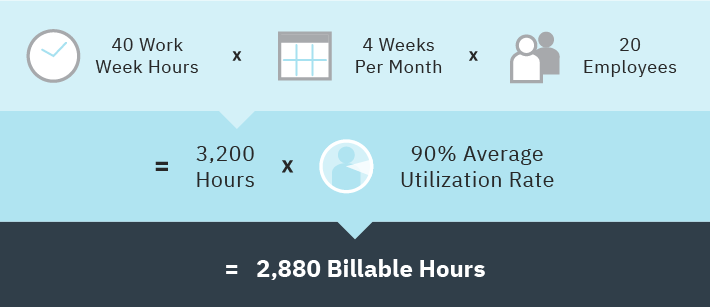While this is true in most industries, companies, like professional service firms that bill by the hour, are particularly affected by this phenomenon. When every billable hour isn’t created equal, how do you measure the health of your firm?
The first step in measuring the health of your firm is to distinguish between different types of hours. It's important to recognize that all hours are not billable to the client. There are various functions within a firm that contribute to its non-billable hours.
Utilization benchmarks for professional services
Important functions like business development, pro bono work, staff training, and team building activities make up a firm’s non-billable hours. They’re not directly billable to a client yet these hours often make the billable work possible by addressing internal firm operations.
The rest of the time constitutes your firm’s billable hours. Combined with non-billable hours, these make up your total available hours.
This is where the all-important utilization rate comes in.
What is the utilization rate?
Utilization rate = Hours worked / Total Available Hours
This metric shows you how much of your employees’ available time is spent on billable work. If the rate is too low, you’re not bringing in enough work for the firm. If the utilization rate is too high, you’ll probably need more resources to handle your workload.
For example, if an employee works 1600 hours out of 1800 available hours, she would have a utilization rate of roughly 88.88%.
Below we’ll discuss the utilization rate a bit further (particularly how it impacts the overall health of your firm), how you can track it, as well as a few strategies to improve it.
Optimizing your firms operational efficiency by measuring utilization rates and related metrics
When measuring your firm’s operational health, it is important to take into account a blend of utilization metrics that encompass various aspects of your business. This holistic approach involves considering the needs of company growth, employee development, revenue, and retention when assessing firm efficiency.
To truly understand the health of your firm, it is crucial to go beyond just looking at billable hours and utilization rates. While these metrics provide valuable insights into productivity and resource allocation, they should be complemented by a broader set of metrics that align with the near-term and long-term objectives of your business.
What is the realization rate?
Realization Rate = Total Billed Hours / Total Billable Hours
Your realization rate measures your total billed hours worked out of all available billable hours for a specific resource.
In the example above, if your firm set aside 200 hours for non-billable work, the total billable hours would be 1600. The employee working 1600 hours would then have a realization rate of 100% (as they billed the maximum number of billable hours).
Calculating both realization and utilization rates on a regular basis is a significant advantage for professional service firms. By tracking these metrics weekly, monthly, or even yearly, firms can gain a deeper understanding of their operational efficiency and make informed decisions to improve profitability.
What is agency realization rate?
Agency Realization Rate = Total Utilization Rate for all Employees / Total Employees
Agency realization rate is a crucial metric that professional service firms use to determine the profitability of their operations. It measures the percentage of billable hours that actually result in revenue for the firm. While it is important to track billable utilization, it is equally important to assess whether the billed work is translating into actual revenue.
You can also calculate the utilization rate for all billable staff with this formula.
If three resources have a utilization rate of 66%, 86%, and 80%, the agency’s utilization rate is 77.34%.
Billable (or chargeable) utilization
This metric identifies the percentage of billable hours that are actually charged to the client.
Chances are, your firm will not get paid for 100% of the billed work. Some hours will be written off or redone, forcing you to eat some of those billed hours. Billable utilization shows you which percentage of your total billed hours actually resulted in revenue.
That’s an important figure when it comes to firm profitability.
The challenge with billable utilization is that it is often delayed since you can’t see within an ongoing project whether revisions will be needed at a later point. Despite this small challenge, you should still track billable utilization on a regularly basis (quarterly is sufficient) to get a sense of what your charging versus what you’re actually billing.
Along with key metrics like realization rate, agency realization rate, and billable utilization, there are a number of other important metrics to consider when measuring your firm’s overall health. Here are a few related metrics that firms use to understand how their time is being spent (and its relative value):
- Annual Revenue per Billable Consultant
- Annual Revenue per Employee
- Project Overruns
- Profit Margin
- Sales Pipeline
- Resource Utilization
How utilization rate affects your agency’s operations
Your utilization rate is a deceptively simple metric.
Leveraged in the right way, it can give you a good deal of insight into your agency’s profitability as well as its productivity. Let us count the ways:
- Demand for services: If you track utilization rate by skill, you can measure the demand for different services your firm offers.
- Track burnout: If your utilization rate is consistently high, then your employees are likely overworked.
- Measure resource allocation: If your utilization rate is often quite low, you likely need to bring in more work for your team.
- Assist with hiring: Tracking your utilization rates by skill and employee type allows you to plan your hiring better.
- Identify gaps: If there is a significant gap between your utilization and realization rates, then your team is spending too much time on non-billable items.
- Show “scope creep”: If your utilization rate is over 100%, this suggests out-of-scope work is being completed and that planning could be improved.
- Identify profitable services: If you link your utilization rates to profits, you can see which services are most profitable for your firm.
- Address client misalignment: If you track your utilization rate by client, you can measure which clients are profitable and which ones tend to drain resources from the firm.
Taken together, your utilization rate, when leveraged correctly, can help you understand your own billing rates better, map skills to actual client demand, develop the talent within your firm, and drive profitability.
How to increase your firm’s utilization rate

You’re not at the mercy of chance when it comes to your firm’s utilization rates.
There are proven ways to boost it.
Time-tracking software will help you measure how time is being used within your firm. Such software also gives you reporting capabilities to help with longer-term strategic shifts in how time is being managed within your firm.
Set utilization rate benchmarks with your employees and offer them resources to meet those ambitious goals. Doing so enlists the entire team in a critical metric in your firm’s profitability. Ideally, you’re tracking utilization rates across the entire agency.
You should also get a handle on how much time your firm is wasting and cut down on aspects of firm life that bring your utilization rates down. Valueless “bench time” should be minimized as much as possible. Invest in a workspace management tool that will automate and streamline labor-intensive tasks while helping you make the most of your employees’ valuable time.
Wherever you are with your current utilization and other firm health metrics, there’s still time to make a few shifts that will improve your firm’s operational efficiency while boosting those profit margins.
Conclusion - understand and improve utilization rates at your professional services company
In conclusion, understanding and tracking utilization benchmarks is crucial for professional service firms to measure the health and profitability of their operations. By distinguishing between billable and non-billable hours and utilizing metrics like realization rate, agency realization rate, and billable utilization, firms can gain insight into their demand for services, resource allocation, and overall profitability.
Additionally, leveraging time-tracking software and setting utilization rate benchmarks can help improve operational efficiency and boost profit margins. To further enhance your firm's utilization rate and optimize productivity, consider investing in workspace management tools and cutting down on valueless "bench time."
By making these strategic shifts, you can ensure that every hour at work is effectively used, ultimately leading to the success and growth of your firm.



